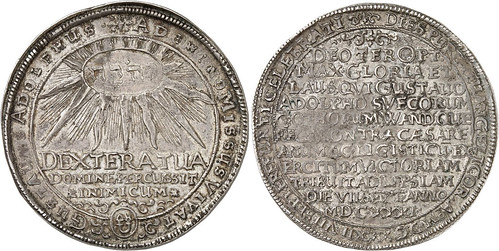
PREV ARTICLE
NEXT ARTICLE
FULL ISSUE
PREV FULL ISSUE
THE 1632 PURIM TALERSA January 20, 2017 article on the Künker firm's website explains the mystery of the "Purim Talers". It would have been too hard to excerpt pieces of the article without
fracturing the story, so here it is in total. The piece is offered in their Berlin Auction 286, part 1, with an estimate of 1,000 euros. -Editor
 Lot 1225: Erfurt. Thaler 1632. Purim taler: “Collectors' term for a 1632 taler from Erfurt, dating from the time of the Swedish occupation, issued on the occasion of a so-called Purim festival, to celebrate the “affirmed Evangelic faith”, on 7 September 1632. The taler received its name from the beginning of the reverse's legend DIES PVRIM (Lat. ‘day of Purim').” This is how the relevant entry in Helmut Kahnt's 2005 “Großes Münzlexikon“, page 369, reads. Some things remain open, though, for example why, in 1632, the city of Erfurt celebrated a Jewish festival. The historical situation Then, in 1631, Swedish King Gustavus Adolphus prevailed near Breitenfeld, and everything was all right. On 2 October, he entered Erfurt. On 4 October, the Erfurt Council swore the oath of fealty to him. The city had a new lord – this time, a Protestant one. The Protestants annex the cathedral The cathedral's chapter received the meagre information that it was planned to hold services in the cathedral according to the Protestant way in the future. After all, they were told, that had been done before (though nobody mentioned that this had been during the 1525 Peasants' War). The canons of course complained to the Swedish resident. But he refused to intervene: Naturally, he didn‘t want to force the cathedral's chapter, but it would be so much better if things could be settled with the council peacefully. Obviously, that didn't work. In the morning of 7 September 1632, representatives of the council forced the cathedral's doors open. Thousands of Protestants flocked into the church, to celebrate “their” service. How the annexation of the cathedral became the Purim festival The strident pastor Valentin Wallenberger gave the feast-day sermon. He compared the commemorative service of the Battle of Breitenfeld with the Jewish Purim festival. The Jewish woman Esther had saved the Jews from being annihilated by the Persians in the same way as, through the Battle of Breitenfeld, Gustavus Adolphus had saved the Protestants from being annihilated by the Catholics. Following the service, a “Resurrection festival” of the Catholic university was celebrated that marked a change to the Protestant doctrines. Of course there were violent incidents – directed at the Catholics and their property but representatives of the council intervened and limited the damage. Thus, it was never about a Jewish feast in Erfurt, but about the Protestants retrieving the most important buildings of their city from the Catholics. The relevant news travelled to all other Protestant cities, as did a print of Valentin Wallenberger's sermon. The Purim talers The reverse translates as: “Purim day of the Evangelicals in 1632, celebrated in Erfurt on 7 September. / Honor and praise be unto God, three times the best and greatest, who had granted Gustavus Adolphus, King of the Swedes, Goths and Wends, victory over the Imperial and the League army near Leipzig on 7 September 1631.” Therefore, it falls too short to think of the Purim talers as a commemorative striking only. They were definitively minted after the events at Erfurt, thus after 7 September 1631, and take up the sermon given by Valentin Wallenberger. In the bad time following the death of Gustavus Adolphus, they reminded the Protestants that the Lord had once sent them a hero to their rescue and might send that hero again at any time. To read the complete article, see: For a modern version of this event, look no further than this article from yesterday's Washington Post about a large protest over the handover of St. Isaac's Cathedral
to the Russian Orthodox Church. -Editor
“We won't give St. Isaac's to the church. We want to save it as a museum,” Boris Vishnevsky, a local lawmaker, told protesters in central St. Petersburg. “St. Isaac's Cathedral is part of our cultural heritage. There are so many valuable exhibits that require the work of museum specialists. The Russian Orthodox Church does not have those specialists,” said Irina Azbel, 43, a doctor, who was among those protesting. A few dozen counterprotesters gathered in the same place to support the plans. “The return of the cathedral to the church is a return to our national roots,” said Yelena Semyonova, 52, a professor. The announcement earlier this month that the neoclassical St. Isaac's Cathedral, which is run as a museum, will be put under Orthodox Church ownership has sparked a backlash from city residents. More than 200,000 people have signed an online petition calling on the city authorities to reconsider. To read the complete article, see:  Wayne Homren, Editor The Numismatic Bibliomania Society is a non-profit organization promoting numismatic literature. See our web site at coinbooks.org. To submit items for publication in The E-Sylum, write to the Editor at this address: whomren@gmail.com To subscribe go to: https://my.binhost.com/lists/listinfo/esylum All Rights Reserved. NBS Home Page Contact the NBS webmaster 
|
